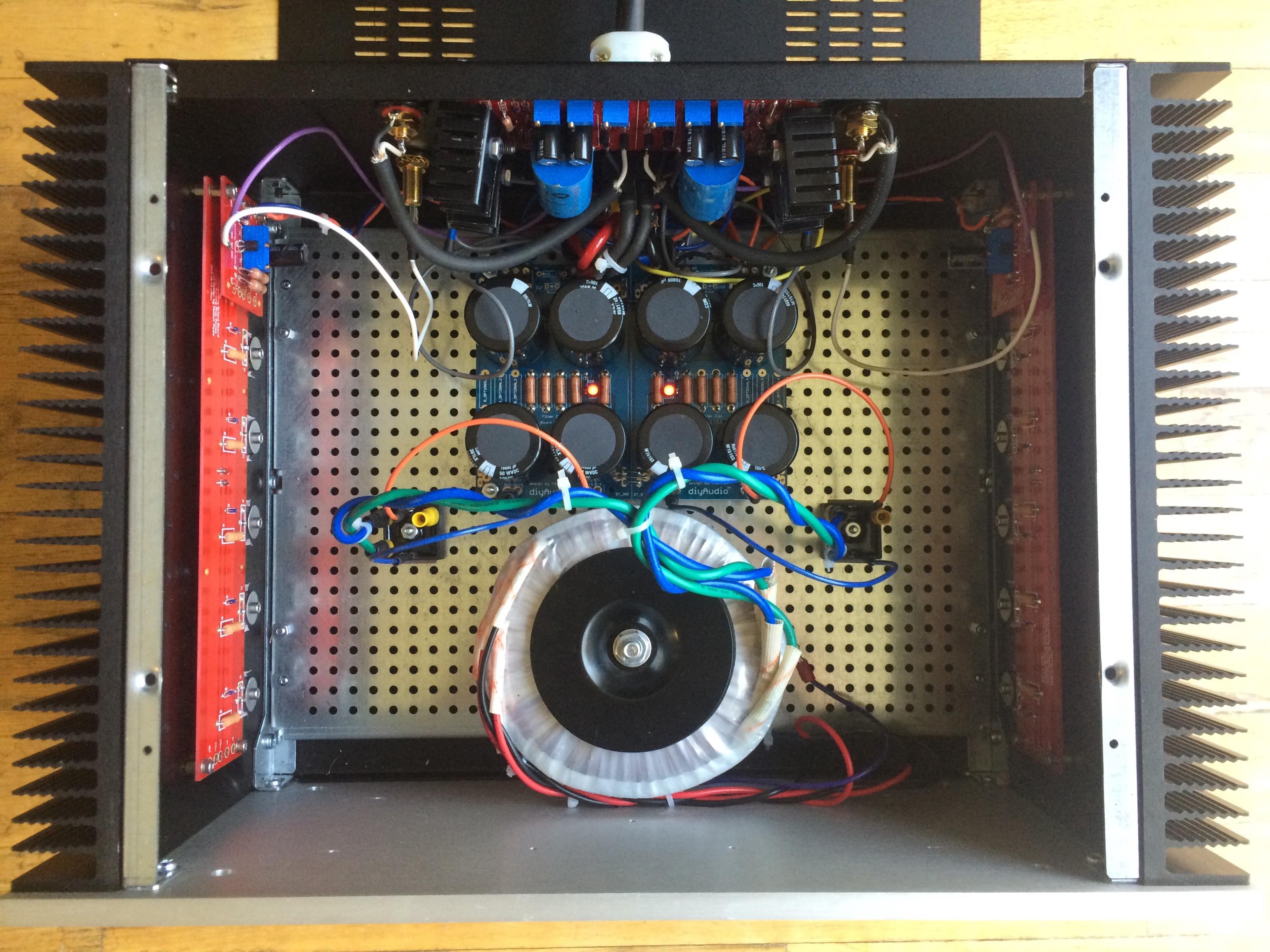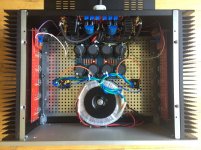After a lot of time trying to zero the offset at the Front End (which proved to be very difficult), I settled for "close enough", at about 0.025 V when in thermal equilibrium.
Now, it is finally up and running! Thanks a lot for the priceless advice!


Now, it is finally up and running! Thanks a lot for the priceless advice!
Attachments
Last edited:
Source Resistors
The build guide mentions that you can use 0R68 or 0R47 in place of the 1R source resistors. I do have output fets matched to +- 0.01Vgs. What is the risk/benefit here? Does this affect dissipation? If so, how? What other factors might I consider here?
The build guide mentions that you can use 0R68 or 0R47 in place of the 1R source resistors. I do have output fets matched to +- 0.01Vgs. What is the risk/benefit here? Does this affect dissipation? If so, how? What other factors might I consider here?
more Cojones , no risk
win-win
I got plenty of cojones, but I am not made of cash!! 😀
I got plenty of cojones, but I am not made of cash!! 😀
He means the amp will have more cojones.
Rush
He means the amp will have more cojones.
Rush
LOL makes sense. Care to elaborate on how this resistor change affects the operation? More specifically i am concerned about dissipation and stability. I am new to amp building and even newer to transistor amps.
Yes it effects dissipation but you can adjust the bias to compensate.
It allows less "buffer" in bias stability between the mosfets...but if your mosfets are well matched you can get away with less source resistance. Less source resistance will allow the amp to go higher in Class A and provide more amps to the speakers. So, sounds better.
I would install .47R and then see if any mosfit "bias hogging" (one mosfet receiving significantly more voltage across source resistors than others) occurs. If not, you are good to go.
It allows less "buffer" in bias stability between the mosfets...but if your mosfets are well matched you can get away with less source resistance. Less source resistance will allow the amp to go higher in Class A and provide more amps to the speakers. So, sounds better.
I would install .47R and then see if any mosfit "bias hogging" (one mosfet receiving significantly more voltage across source resistors than others) occurs. If not, you are good to go.
Okay i have a problem that has me stumped. I have just begun to bias the FE boards. When i start the variac and slowly increase voltage my R10&11 begin showing voltage drop with the pots zeroed and variac not even close to mains voltage. In fact its about +-5 VDC coming out of the power supply. Anyone got any suggestions?
Okay i have a problem that has me stumped. I have just begun to bias the FE boards. When i start the variac and slowly increase voltage my R10&11 begin showing voltage drop with the pots zeroed and variac not even close to mains voltage. In fact its about +-5 VDC coming out of the power supply. Anyone got any suggestions?
Disregard... i had Q1 & 2 switch on one channel. Good thing i was gentle with the variac. The jfets are fine.
Okay. I have been letting the amp burn in and try to reach equilibrium on the sinks. All was great until i went to go measure the bias. Soon after connecting the meter leads the transformer started buzzing. Everything otherwise seems fine. No smoke, bias still seems good, put music through it and sounds great, but there is a fairly loud hum now coming from my transformer. Which is a 600VA Antek 24x2. Any ideas? Could one/more output device be bad and draw a bunch of power but the amp still works?
They are connected on opposite ends of one of the source resistors. It still buzzes when they come off too.
So I unplugged the leads from the rectifiers to the power supply boards essentially removing any load from the transformer and it still hums. I’m thinking there is a mechanical error in the construction of the transformer. Maybe it was just coincidence that it started humming when i was taking readings. The music from the amp sounds fantastic, bias is steady around .3V across the source resistors. Maybe i will see if Antek will exchange it.
Had a similar experience on a duel mono LM I built. One transformer noisy, one not. At the suggestion of someone here I tightened the retaining bolt on the noisy transformer a little. It must have been vibrating a little. No more noise for two years now.
Had a similar experience on a duel mono LM I built. One transformer noisy, one not. At the suggestion of someone here I tightened the retaining bolt on the noisy transformer a little. It must have been vibrating a little. No more noise for two years now.
I will do this tonight. After letting the amp rest overnight Saturday night, Sunday the buzz was gone. I'm guessing the heat from leaving it on all day Saturday softened the insulation and whatever they use keep things tight, allowing some things to loosen up. I will take the added measure to tighten it up a little more.
Public Service Announcement: The BA-3 is absolutely incredible sounding. it is holographic, huge soundstage, dynamic, absolute black background. These properties come to mind after 20 hours of burn in and 5 or so hours of listening. I recently built F5T V3 monos which are amazing as well but i think i like the BA-3 just a tiny bit more. And it is in my secondary system.
to airborne11 #2377
Hello airborne11,
yes, the BA-3 is a fantastic amp! This is why I built two of them.
I also have F-5 T - Monoblocks. I prefer them on my ESLs.
Both are very good sounding designs. It depends what is hanging on your amp -
what kind of loudspeaker.
And both are running hot!
Check your temperatures on the heatsinks in summer. But in the states you have -most often- aircondition in the house.
Enjoy your listening sessions with your BA-3!

Greets
Dirk
Hello airborne11,
yes, the BA-3 is a fantastic amp! This is why I built two of them.
I also have F-5 T - Monoblocks. I prefer them on my ESLs.
Both are very good sounding designs. It depends what is hanging on your amp -
what kind of loudspeaker.
And both are running hot!

Check your temperatures on the heatsinks in summer. But in the states you have -most often- aircondition in the house.
Enjoy your listening sessions with your BA-3!

Greets
Dirk
- Home
- Amplifiers
- Pass Labs
- Burning Amp BA-3



